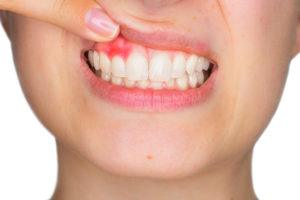
It’s easy to assume that gum disease is only a problem that affects other people. But, if you are over the age of 30, then it means that you have a 50% chance that you will develop a gum infection. If the infection is left untreated, then it could lead to serious dental issues that can be harmful to your overall health.
Prevention is the Best Solution
While there are treatments for gum disease, the best solution is to prevent the issue before you are dealing with bigger problems in the future. Typically, gum disease develops due to poor dental habits. If you aren’t removing plaque buildup on your teeth by brushing and flossing, then bacteria can cause an infection in the gums. Staying consistent with these oral health habits will help you avoid potential infections in the future.
Early signs of gum disease include tender, swollen, red gums. You might notice that the gums bleed when you floss or brush. As the infection progresses, then your teeth might become loose or there could be pus-filled areas in the gums. Regardless of the severity of the infection, it is important that you talk to your dentist about treatments.
Treatment Options for Healthy Gums
What should you do if you’ve been diagnosed with gum disease? The first step is to maintain more consistency with your oral health habits. Minor symptoms of gum disease will go away with regular brushing and flossing. But, there are times when professional dental treatments might be required.
Early detection is essential to help you avoid invasive treatments in the future. At first, in-office treatments might be focused on deep cleaning under the gum line. A normal cleaning appointment only treats the visible parts of the teeth. On the other hand, in-depth cleaning requires the dental professional to work below the gum line using special instruments to remove the plaque and buildup. Scaling and root planing are two techniques that might be used in this treatment.
Continuing Treatments
When the initial deep cleaning treatments aren’t sufficient for gum disease, then the next step is to try medications. The goal is to eliminate the infection, so antibiotics or antiseptics might be used. Small gel particles can be placed in the infected areas of the gums to kill the bacteria. The medication is released over time, helping to get rid of the infection. As a result, the infection pocket will decrease as the gums heal.
Sometimes oral antibiotics are required for serious infections. A prescription will be written, and you will need to take these tablets daily until the prescription is finished. You might also be given a special mouthwash that helps with the treatment and prevention of gum disease.
The last option is to have gum surgery. Either the gums are lifted to clean deep below the gum line. Or, if the gums have receded, then a gum graft surgery might be required to cover exposed tooth roots.
Everyone should maintain regular dental exams to avoid common forms of dental disease. For more information, schedule an appointment with our team at myDental at one of our locations in the nearby area: Tech Ridge and Norwood Park.